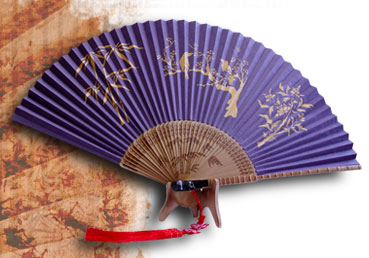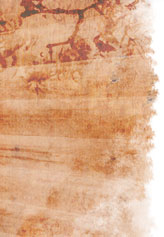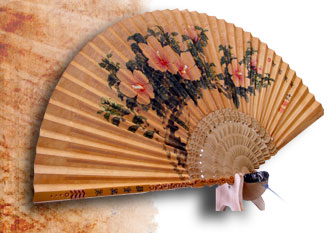 In Korea there has been a tradition of giving a hand fan as a special gift for the Dano Festival (the In Korea there has been a tradition of giving a hand fan as a special gift for the Dano Festival (the
 fifth day of the fifth lunar month), a nationwide custom held by people of all classes, from the
fifth day of the fifth lunar month), a nationwide custom held by people of all classes, from the
 royal family to common folks. The fan granted by the king to his ministers on that particular
royal family to common folks. The fan granted by the king to his ministers on that particular
 day was called Danoseon, or Dano Fan. The establishment of this custom is related to
day was called Danoseon, or Dano Fan. The establishment of this custom is related to
 the Korean climate, because in Korea Dano is considered a herald of hot summer
the Korean climate, because in Korea Dano is considered a herald of hot summer
 weather. For many Koreans, giving a hand fan to prepare for the sweltering summer has
weather. For many Koreans, giving a hand fan to prepare for the sweltering summer has
 been an important way of showing their love and care for one other.
been an important way of showing their love and care for one other.
 The city of Jeonju in Jeolla province is where Korea’s best fans are produced. The city of Jeonju in Jeolla province is where Korea’s best fans are produced.
 During the Joseon period (1392-1910), the local administration of Jeonju,
During the Joseon period (1392-1910), the local administration of Jeonju,
 (the home of Korea’s finest mulberry paper and a city located near Damyang,
(the home of Korea’s finest mulberry paper and a city located near Damyang,
 which is famous for quality bamboo and bamboo products), established a fan-making
which is famous for quality bamboo and bamboo products), established a fan-making
 workshop where it produced hand fans to send to the king as a tribute. The fact that Jeonju was able to
workshop where it produced hand fans to send to the king as a tribute. The fact that Jeonju was able to
 manufacture durable, lightweight mulberry paper that, “lasts 1000 years whereas cotton for half of it,"
manufacture durable, lightweight mulberry paper that, “lasts 1000 years whereas cotton for half of it,"
 which became one of Joseon’s major export items, also helped the city become the home of quality hand fans.
which became one of Joseon’s major export items, also helped the city become the home of quality hand fans.
Because fan making was a job that required advanced skills, workmanship and expertise, masters of fan making,
called Seonjajang, were greatly admired. It is here at Jeonju, the home of Korean decorative fans, that Seonjajang
Yi Gi-dong runs his workshop, preserving the tradition of fan making that has been cherished for more than 1000 years.
Seonjajang Yi has devoted himself to the vocation of introducing the beauty of hapjukseon to modern life for more than
50 years, ever since he was 17 years old. Born to a poor family, his childhood days were hard, and he had to work odd
jobs to help ease the financial difficulties his family was facing. He lost his father when he was 11 years old, and had to
move with his mother to Jeonju where her parents were living. While in Jeonju, he was introduced to the art of
hand fan making in accordance to advice from his relatives. He found a job at a local fan-making workshop and
began to learn about hand fan making from an artisan named Bae Gwi-nam, who was regarded as the best
hapjukseon maker in the area.
 The learning process was extremely hard, as he had to work seated and hunched over in a tiny room until The learning process was extremely hard, as he had to work seated and hunched over in a tiny room until
 his legs were numb. However, his sincere attitude toward the work and his outstanding talent helped his legs were numb. However, his sincere attitude toward the work and his outstanding talent helped
 him master the skills required to open his own workshop. But before starting his own business, he him master the skills required to open his own workshop. But before starting his own business, he
 wanted to return the favor he had received and continued to work for his tutor for another wanted to return the favor he had received and continued to work for his tutor for another
 three years. Once he opened his own workshop, he concentrated on hapjukseon making three years. Once he opened his own workshop, he concentrated on hapjukseon making
 his entire life, despite the fact that his business was hit hard by the arrival of electric fans, his entire life, despite the fact that his business was hit hard by the arrival of electric fans,
 and he sometimes had to worry about putting food on the table. However, no ordeal could and he sometimes had to worry about putting food on the table. However, no ordeal could
 break his pride in preserving the tradition of hapjukseon making that had been a tradition break his pride in preserving the tradition of hapjukseon making that had been a tradition
 of Korea for more than 1000 years as well as his drive to bring glory to the beauty of hapjukseon. of Korea for more than 1000 years as well as his drive to bring glory to the beauty of hapjukseon.
 In 1972 he began to recover his confidence in his work as he started to receive awards in In 1972 he began to recover his confidence in his work as he started to receive awards in
 traditional handicrafts fairs and competitions, and gain a nationwide reputation. In 1993, the traditional handicrafts fairs and competitions, and gain a nationwide reputation. In 1993, the
 provincial administration of Jeollabuk province officially recognized his advanced skills and provincial administration of Jeollabuk province officially recognized his advanced skills and
 achievement in preserving and developing the tradition of hapjukseon by granting him the honorary achievement in preserving and developing the tradition of hapjukseon by granting him the honorary
title of Seonjajang, or Master Craftsman of Fan Making, and making him a 'Human Cultural Property.' In fact, his hapjukseon
was offered to Queen Elizabeth II as an artwork representing Korea when she visited the nation in 1999. In the meantime,
he raised his son and son-in-law to be great fan makers to succeed the family business. However, he isn’t satisfied with
the achievements he has made so far, and says that he has not yet made a really fine work of art that captivates his heart.
His devotion and sincerity doesn't change during the entire process of making hapjukseon, from selecting the bamboo to
the final stage of nakjuk engraving, to producing a fine piece of hapjukseon for the world.
View the master's works
|



















